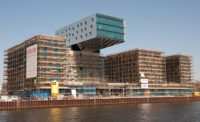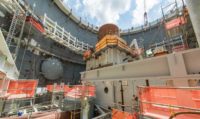This summer, Denis Hayes is “off the grid.” But Seattle’s celebrated sun worshipper— known for growing Earth Day into a global environmental movement and for masterminding a living laboratory for ultra-green commercial office buildings—is not lying on a beach soaking up the rays. He is sequestered in Berlin, as a fellow of the Robert Bosch Academy, writing what he hopes will be the definitive book on direct solar energy.
“The dominant future power source will be sunlight turned directly into electricity,” predicts Hayes, president and CEO of the nonprofit Bullitt Foundation, which developed the world’s greenest building—the two-year-old Bullitt Center. “I’ve been pushing that message consistently since the mid-1970s, but with no meaningful success at the national level since Reagan replaced Carter.”
Hayes maintains that direct solar power, which is beginning to gain traction, holds more promise than indirect solar, such as hydropower, biomass and wind energy. His book will explore the remaining obstacles to direct solar and the promise of new technologies that will ultimately make it “really cheap and long-lasting.”
Hyper-Focused
If anyone can lead the way to a post-petroleum economy, Hayes can, claim his supporters. They describe the nearly 71-year-old environmental activist as a hyper-focused, inspirational organizer, leader and innovator. He is called brilliant, wise, modest, collaborative and passionate, yet calm.
“Denis projects a unique combination of big vision and practical innovation,” says Washington Gov. Jay Inslee (D). “He’s unshakeable—he holds an unwavering commitment to dealing with environmental challenges and a belief that we can create technological innovations to [solve] them.”
For nearly a quarter century, Hayes has used his broad professional network and his position at the Bullitt Foundation to bring together key thinkers and doers to address grand challenges, pushing leaders to move beyond conventional thinking, says Lisa J. Graumlich, dean of the College of the Environment at the University of Washington. “Bullitt Center epitomizes his out-of-the-box thinking,” she adds.
The six-story living laboratory—which last year produced 60% more electricity than it used, thanks to a rooftop solar array and occupants’ judicious use of power—also is the first example of Hayes’ long-held idea to pattern city life on nature’s ecosystems, now called biomimicry.
Replicable Models
Thanks to Hayes, the 52,000-sq-ft Bullitt Center—occupied by the seven-person foundation staff and seven tenants—offers the buildings sector replicable investment, development, financial, permitting, design, construction and operational models for self-sustaining buildings made from materials free of harmful ingredients.
“Denis would be disappointed if Bullitt Center is still the most energy-efficient building in the world in five years,” says William D. Ruckelshaus, a strategic director of the Madrona Venture Group, a Bullitt board member and the first administrator of the U.S. Environmental Protection Agency. “He wants others to build better buildings,” using this one as a prototype.










Post a comment to this article
Report Abusive Comment